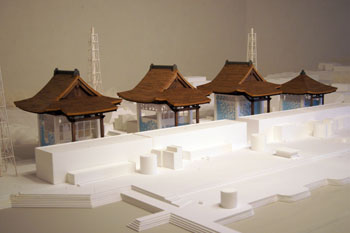
Fukushima no. 1 nuclear power plant reenvisaged as Shinto shrines
Here’s an odd but intriguing idea: a plan to convert the failed nuclear power stations of Fukushima into Shinto shrines!! And no, it’s not an April 1 joke, for the article was posted on March 18 in the Japan Times. (Click here.)
The proposal to convert nuclear power into spiritual power is the brainchild of an architect called Katsuhiro Miyamoto…
The 51-year-old who, in 1996, represented Japan at the “Olympics of architecture” — as the Venice Biennale is known — has suggested erecting giant shrine-style thatched roofs over each of the crippled reactor buildings — and so creating what he dubs “The Fukushima No. 1 Nuclear Power Plant Shrine.” This, he tells The Japan Times, will “pacify a malevolent god.”
As yet, no long-term strategy for dealing with the now highly radioactive plant operated by Tokyo Electric Power Co. has been developed. Far from it, in fact, since work is still ongoing to stabilize the leaking reactors. Ultimately, however, Miyamoto believes the key issue will be what to do with the highly radioactive nuclear fuel that either remains in or has melted through the reactors’ containment vessels.
“They won’t be able to bury it on the site because the land there is not geologically stable enough, and I doubt they will be able to take it off the site because no other local government will agree to take it,” Miyamoto observes. “That means they will have to stabilize it somehow and more or less leave it where it is.”
That done, the next task as he sees it would be one he believes architects are uniquely positioned to address: the creation of some kind of structure above and around the reactors that will convey to future generations — possibly for 10,000 years — the danger of what lies within.
In this respect he points out that, “Whereas the original blue confetti-like pattern painted on the reactor buildings seems like a device to conceal danger, a shrine-like structure will do the opposite.”
As to the choice of a shrine-like appearance — rather than, say, giant skull-and-crossbones graphics adorning the buildings — Miyamoto concedes that “not all Japanese would describe themselves as ‘believers’ in Shinto.” Nonetheless, he thinks “most would agree that when they visit a shrine they sense a kind of inexplicable power there. Shrines have been conveying that impression for many generations already, and they are likely to do so in the future, too.”
The architect notes that with thatched roofs topping each of the six reactor buildings at the Fukushima No. 1 plant, the site will come to resemble Uesugi Ancestral Hall in the city of Yonezawa, Yamagata Prefecture, where 12 small shrines laid out in a line commemorate 12 successive generations of the Uesugi clan’s feudal lords, whose lives spanned more than 250 years from 1623-1876.
And like that ancestral hall, the architect believes the Fukushima No. 1 Nuclear Power Plant Shrine “will respectfully serve as an icon to enshrine the souls of the departed” — but unlike it, “it will also deter anyone from approaching.”

Leave a Reply